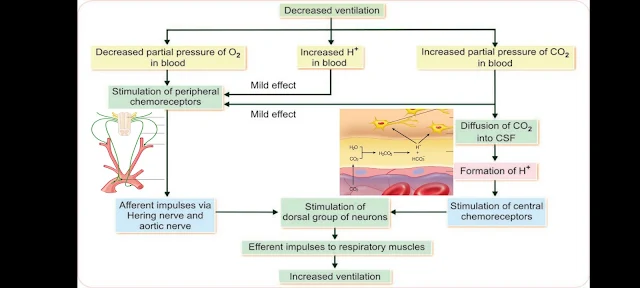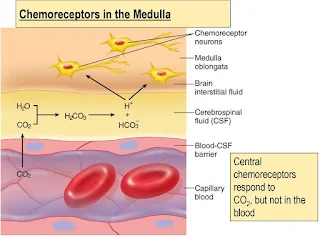Chemical control of ventilation
Chemical control of ventilation
Introduction:
- During emotion and exercise increase respiratory rate and force. But the pattern of respiration is come back to normal, within a short time by some regulatory mechanisms in the body.
- These mechanism are two types there are:
- Nervous or neural mechanism
- Chemical mechanism.
Chemical mechanism:
- Chemical mechanism of regulation of respiration is operated through the chemoreceptors.
- Chemoreceptors are the sensory nerve endings, which give response to changes in chemical constituents of bloód
- 1. Hypoxia (decreased p02)
- 2. Hypercapnea (increased pCO2)
- 3. Increased hydrogen ion concentration
Types of chemoreceptors:
1.Central chemoreceptors
2.Peripheral chemoreceptors
1.Central chemoreceptors:
Central chemoreceptors are present in the brain.
Situation:
- Central chemoreceptors are located in deeper part of medulla oblongata, close to the dorsal respiratory group of neurons.
- This area is called as chemosensitive area and the neurons are called chemoreceptors.
- Chemoreceptors are close contact with blood and cerebrospinal fluid.
Mechanism of action : central chemoreceptors:
- Central chemoreceptors are stimulated by hydrogen ions, however the blood hydrogen ions doesn't stimulated central chemoreceptors because the Blood H ions doesn't cross through the blood brain barrier and blood cerebrospinal fluid barrier.
- In other way the invreased blood CO2 able to cross the blood brain barrier and blood cerebrospinal fluid barrier and enter into interstitial fluid of brain or cerebrospinal fluid
- The CO2 combine with H2O to form carbonic acid, Since carbonic acid is unstable, it immediately dissociates into hydrogen ion and bicarbonate ion
- CO2 + H2O → H2CO3 –→ H+ + HCO3
- H- ions stimulate the central chemoreceptors. From chemoreceptors, the excitatory impulses are sent to dorsal respiratory group of neurons(DGN).
- result of increased ventilation (increased rate and force of breathing). Because of this, excess carbon dioxide is washed out and respiration is back to normal.
- Lack of Oxygen does not have significant effect on the central chemoreceptors, except that it generally depresses the overall function of brain.
2.Peripheral chemoreceptors:
 |
| Peripheral chemoreceptors |
- Peripheral chemoreceptors are the chemoreceptors present in carotid and aortic region.
Mechanism Of Action:
- peripheral chemoreceptors O2 sensitive potassium channels in the glomus cells of peripheral chemoreceptors.'
- ( Hypoxia) decrease O2 level cause closure of O2 sensitive potassium channels and prevents potassium efflux.
- This efflux cause depolarization of glomus cells (receptor potential) and generation of action potentials in nerve ending.
- These impulse pass through aortic and Hering nerves and excite the dorsal group of neurons. Dorsal group of neurons (DGN) in turn, send excitatory impulses to respiratory muscles, resulting in incréased ventilation.
- This provides enough oxygen and rectifies the oxygen demand.
- The peripheral chemoreceptors are also stimulated by:
- hypercapnea and
- increased hydrogen ion concentration.
 |
| Central and peripheral chemoreceptors |
MOA (hint):
- Glomus cell (O2 sensitive)
- Depolarisation of glomus cells( due to decrease O2)
- Impulse pass through the hering and aortic nerve)
- Dorsal respiratory group of neuron (medulla oblengata)
- (Turn back impulse to respiratory muscle) to turn back of normal ventilation




No comments:
Post a Comment